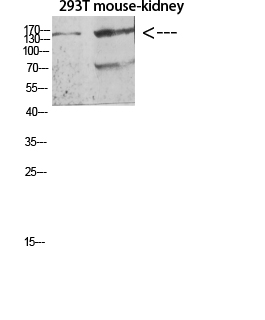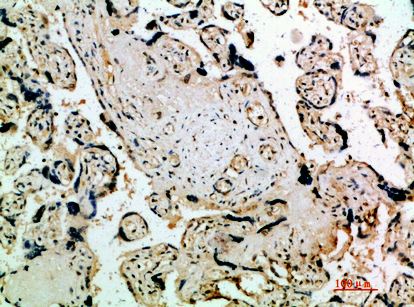产品名称
Flt-4 Rabbit Polyclonal Antibody
别名
Vascular endothelial growth factor receptor 3 (VEGFR-3;EC 2.7.10.1;Fms-like tyrosine kinase 4;FLT-4;Tyrosine-protein kinase receptor FLT4)
蛋白名称
Vascular endothelial growth factor receptor 3 (VEGFR-3) (EC 2.7.10.1) (Fms-like tyrosine kinase 4) (FLT-4) (Tyrosine-protein kinase receptor FLT4)
存储缓冲液
Liquid in PBS containing 50% glycerol, 0.5% BSA and 0.02% New type preservative N.
Human Gene Link
http://www.ncbi.nlm.nih.gov/sites/entrez?db=gene&term=2324
Human Swissprot No.
P35916
Human Swissprot Link
http://www.uniprot.org/uniprotkb/P35916/entry
Mouse Swissprot No.
P35917
Mouse Swissprot Link
http://www.uniprot.org/uniprot/P35917
Rat Swissprot Link
http://www.uniprot.org/uniprot/O54941Q91ZT1
免疫原
Synthetic peptide from human protein at AA range: 640-700
特异性
The antibody detects endogenous Flt-4
稀释度
WB 1:500-2000,IHC-p 1:500-200, ELISA 1:10000-20000. IF 1:50-200
宿主
Polyclonal, Rabbit,IgG
背景介绍
This gene encodes a tyrosine kinase receptor for vascular endothelial growth factors C and D. The protein is thought to be involved in lymphangiogenesis and maintenance of the lymphatic endothelium. Mutations in this gene cause hereditary lymphedema type IA. [provided by RefSeq, Jul 2008],
组织表达
Detected in endothelial cells (at protein level). Widely expressed. Detected in fetal spleen, lung and brain. Detected in adult liver, muscle, thymus, placenta, lung, testis, ovary, prostate, heart, and kidney.
细胞定位
Cell membrane ; Single-pass type I membrane protein. Cytoplasm . Nucleus . Ligand-mediated autophosphorylation leads to rapid internalization. .; [Isoform 1]: Cell membrane; Single-pass type I membrane protein. Ligand-mediated autophosphorylation leads to rapid internalization.; [Isoform 2]: Cell membrane; Single-pass type I membrane protein.; [Isoform 3]: Secreted. Cytoplasm.
信号通路
Cytokine-cytokine receptor interaction;Focal adhesion;
功能
catalytic activity:ATP + a [protein]-L-tyrosine = ADP + a [protein]-L-tyrosine phosphate.,disease:Defects in FLT4 are found in juvenile hemangioma. Juvenile hemangiomas are the most common tumors of infancy, occurring as many as 10% of all births. These benign vascular lesions enlarge rapidly during the first year of life by hyperplasia of endothelial cells and attendant pericytes, and then spontaneously involute over a period of years, leaving loose fibrofatty tissue.,disease:Defects in FLT4 are the cause of lymphedema hereditary type 1 (LYH1A) [MIM:153100]; also known as Nonne-Milroy lymphedema or Milroy disease. Hereditary lymphedema is a chronic disabling condition which results in swelling of the extremities due to altered lymphatic flow. Patients with lymphedema suffer from recurrent local infections and physical impairment.,function:Receptor for VEGFC. Has a tyrosine-protein kinase activity.,online information:FLT4 entry,similarity:Belongs to the protein kinase superfamily. Tyr protein kinase family.,similarity:Belongs to the protein kinase superfamily. Tyr protein kinase family. CSF-1/PDGF receptor subfamily.,similarity:Contains 1 protein kinase domain.,similarity:Contains 7 Ig-like C2-type (immunoglobulin-like) domains.,tissue specificity:Placenta, lung, heart, and kidney, does not seem to be expressed in pancreas and brain.,
纯化
The antibody was affinity-purified from rabbit antiserum by affinity-chromatography using epitope-specific immunogen.


